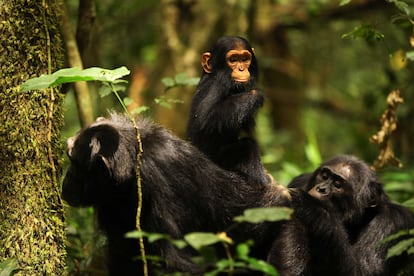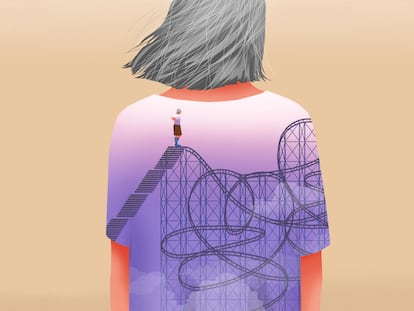Chimpanzees also go through menopause
The discovery shows that humans are not the only primate to live beyond their reproductive years and adds mystery to this apparent evolutionary illogic
Marlene was 69 years old when she died. Ma Rainey was 64 when she passed away. Sutherland, 61, was still alive in October 2023 when scientists confirmed that all three had undergone or are going through menopause. They are three chimpanzees from a group living deep in the jungles of Uganda, Africa, where dozens of older females stopped ovulating years ago. This discovery, which was just published in Science, dismantles the idea that humans are the only primates to live beyond their reproductive years. The finding challenges hypotheses about menopause’s evolutionary role, but, if confirmed to be exceptional, could show the tremendous damage humans have done to the rest of the great apes.
One of the largest, best-preserved populations of Pan troglodytes, the scientific name of chimpanzees, with the least human contact is located in Uganda’s Kibale National Park. Since the mid-1990s, scientists from the Ngogo Chimpanzee Project have been following a group of dozens of individuals. They knew almost everything about them: age, sex, number of offspring and with whom they were conceived, even the genetic data of the whole group. From the 185 females that have formed part of the community, the equivalent of 1,611 years of observations are available. Researchers have found that these chimpanzees live up to 19.5 years after they stop reproducing.
Since 2001, Kevin Langergraber has been spending long periods of time in Kibale studying the chimpanzees of Ngogo, to the point that he could name them all, “except for the many offspring,” the Arizona State University biologist admits. He is the co-author of this study in Science and emphasizes that “previous work with other chimpanzee communities in the wild that used demographic data as we have done (dating of births and deaths) had shown the absence of a substantial post-reproductive life expectancy.” To verify this, researchers recorded the time since the last pregnancy or genital swelling (a sign of ovulation) and counted the number of years each female didn’t have an offspring and if and when she died. They called this time span the survival ratio (PrR). When survival and fertility are parallel, as is the case with females of the vast majority of species, their PrR is 0 or close to it. For females in traditional hunter-gatherer communities (they discarded comparisons with those in modern societies because of the distortion their extended life expectancy introduced), this ratio rises to 0.44. In the Ngogo chimpanzees it reached 0.19. That means that a fifth of their adult lives is post-reproductive.
To confirm this, they analyzed the chimpanzees’ urine for a typical menopausal endocrine pattern. As the end of egg reserves approaches, a parallel process occurs in humans and chimpanzees: while estrogen and progesterone production decreases, the production of two other hormones, luteinizing hormone (LH) and follicle stimulating hormone (FSH), increases, because they will run out of eggs to act on. In menopausal humans, the concentration of LH increases by up to five times, while that of FSH increases by up to 15 times. In Ngogogo females, the increase ratio is very similar.
Ngogo Chimpanzee Project co-director, evolutionary anthropologist Melissa Emery Thompson, highlights the finding: “While there are many reasons why older females might have reproductive problems (e.g., poor health or sterility), this study is the first to definitively demonstrate, using the same hormonal markers used to diagnose perimenopause and menopause in humans, that the chimpanzees have ceased reproduction due to menopause.
Evolutionary logic
Menopause has been a challenge for scientists. Under natural selection, favoring genes that extend life beyond the reproductive years does not make biological sense. In theory, genes that prolong the chances of reproducing and thus perpetuating the species should be favored. And that’s how it is in almost all vertebrate species: for centuries it was believed that, of the more than 50,000 species of fish, amphibians, reptiles, birds and mammals, only humans stopped ovulating long before biological senescence. So far this century, the discovery that orcas and later other odontocete cetaceans (pilot whales, narwhals, beluga whales and black killer whales) also go through menopause has eliminated the human species’ exceptionalism. Several theories have been put forward to explain why the decoupling of reproductive life span from life span occurred in only six species. The theory with the greatest consensus was the grandmother hypothesis: in its simplest version, it posits that, in their evolution, humans who reached definitive amenorrhea could help their daughters to raise their offspring, increasing the group’s chances of survival. But the Ngogo chimpanzees have complicated everything.
Like any great discovery, it raises more questions than it answers: how is it possible that, as one of the most studied and closest species to humans (along with bonobos), the fact that female chimpanzees go through menopause was not discovered earlier? At the beginning of this century, an ambitious work with several chimpanzee communities led by Thompson confirmed previous research: they found no evidence that menopause is a characteristic feature of these apes.

So, what is so special about the Ngogo chimpanzees? One possibility that the study’s authors suggest is that this community lives in a kind of paradise: since the last leopard was killed in the 1960s, they have no predators in the region. So far this century, they have increased their territory —which was already very rich in food— by 22%. In addition, the community shows the species’ highest known vegetative growth rate in the wild and they have not experienced any major man-made cataclysms (persecution, pathogens...). Consequently, group members’ life expectancy has increased. And like females of other species, chimpanzees have a fixed number of eggs that are used up at around 47 years of age; like humans and some cetaceans, as they live longer, the chimpanzees enter a post-reproductive phase.
Biologist Daniel Franks, a researcher at the University of York (UK), has been studying menopause in killer whales for years. Franks agrees with the authors that the discovery could be an artifice caused by conditions that are as exceptional as they are (possibly) temporary. Some cases of menopausal chimpanzees had already been documented in captivity, where there are predators or diseases and they have good food.
The grandmother hypothesis
“There is a highly suggestive alternative, which the authors hint at, that postmenopausal survival has actually been quite common among chimpanzee groups, implying that it could be evolutionarily beneficial. If true, that would be huge,” Franks notes. The rationale is that scientists haven’t seen it in other chimpanzee groups because, unlike the Ngogo chimps, “these other groups live in deteriorated habitats due to the negative impact of humans, and they experience extremely high mortality from human diseases.” So, it is not so much that the Kibale chimpanzees live longer and therefore go through menopause, but rather that the others live for less time and do not experience menopause. This idea would have to be confirmed by research in other groups with other great apes, particularly their sister species, the bonobos.
If menopause has existed in chimpanzee genetics for a long time, far from clarifying the function of this vital mechanism, the issue becomes more complicated. Thus far, the grandmother hypothesis has been confirmed in humans and cetaceans, and it explains the evolutionary functionality of a post-reproductive life phase. Menopausal mothers would spend the time they do not devote to possible offspring of their own to caring for their grandchildren. But this does not apply to chimpanzees. In this species (and in Ngogo chimpanzees), females leave the community where they were born when they reach reproductive age and have their offspring in another group, so their mothers cannot lend a hand in rearing them. In addition, the aggressive relationship between communities and even within the same community is well known, making mother-to-daughter support even more complicated.
Evolutionary biologist Michael Cant of the University of Exeter sheds some light on this mystery: “Classical theory based on Darwin’s theory of natural selection predicts that any gene that extended life beyond the end of reproduction would not be selected; it would be invisible to natural selection because it would not confer any reproductive advantage.” However, there are exceptions that would provide an advantage: “Post-reproductive survival could evolve if it conferred benefits to genetic relatives, that is, if older post-reproductive females (or males) could sufficiently boost the survival and reproduction of their offspring.” That is what happened with Ngogo females. Among some of the brainiest and most socially complex species, it is important to ensure their own direct or indirect genetic transmission. Consequently, among humans that life expectancy has been increased without extending the reproductive years, which we have not allowed chimpanzees to do, except for the ones in Ngogo.
Professor Ignasi Roig, head of the team at the Institute of Biotechnology and Biomedicine of the Autonomous University of Barcelona, was part of the group that identified the genetic keys to human menopause two years ago. He is not a primatologist, nor, as he notes, is his field the evolution of menopause, but he argues that theories such as the grandmother theory or other forms of collaboration would explain this mechanism. From his perspective, it would be relevant in species such as ours or some cetaceans in which “individuals live many years, establish a social environment and the offspring have long periods of dependence where they require maternal care.” Ngogo’s chimpanzees now meet all of these conditions. Roig recalls that “the ovary is the aging body’s lookout; it is the first organ that ages.” For millennia, that was not an obstacle, but rather an evolutionary advantage. But now, with such a long life expectancy and late childbearing, menopause is starting to be an evolutionary problem.
Sign up for our weekly newsletter to get more English-language news coverage from EL PAÍS USA Edition
Tu suscripción se está usando en otro dispositivo
¿Quieres añadir otro usuario a tu suscripción?
Si continúas leyendo en este dispositivo, no se podrá leer en el otro.
FlechaTu suscripción se está usando en otro dispositivo y solo puedes acceder a EL PAÍS desde un dispositivo a la vez.
Si quieres compartir tu cuenta, cambia tu suscripción a la modalidad Premium, así podrás añadir otro usuario. Cada uno accederá con su propia cuenta de email, lo que os permitirá personalizar vuestra experiencia en EL PAÍS.
¿Tienes una suscripción de empresa? Accede aquí para contratar más cuentas.
En el caso de no saber quién está usando tu cuenta, te recomendamos cambiar tu contraseña aquí.
Si decides continuar compartiendo tu cuenta, este mensaje se mostrará en tu dispositivo y en el de la otra persona que está usando tu cuenta de forma indefinida, afectando a tu experiencia de lectura. Puedes consultar aquí los términos y condiciones de la suscripción digital.











































